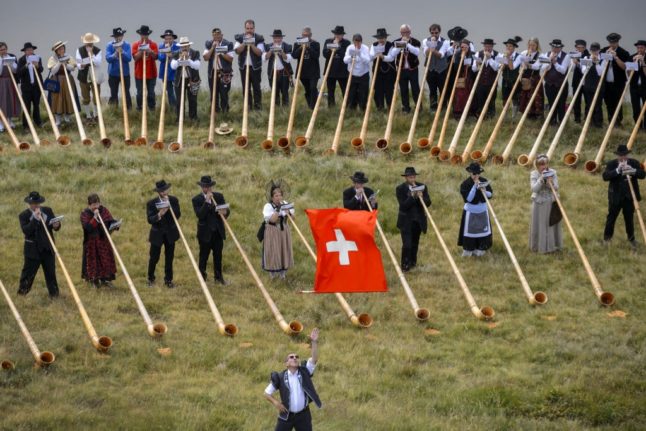The Federal Office of Culture (FOC) recently updated its 10-year-old “List of living traditions in Switzerland”, and asked the population to contribute to it.
‘Living traditions’ are those that have transcended centuries and are still practiced in various Swiss regions today.
“The list currently includes 199 important forms of intangible cultural heritage. The focus in this update will be on the contribution of living traditions to sustainable development”, FOC announced.
Among events already on the list are old and mostly familiar customs such as Alpine pasture season, cow fighting, yodelling, alphorn playing, and Basel Fasnacht, to name just a few.
But the list also contains more unusual entries that few people outside the regions where they are practiced know about.
These are some of them:
Despite its curious title, these days this tradition has little to do with a limping delivery person, though this might have been the case in 1701, when Switzerland’s oldest almanac was created.
Then, as now, this annual handbook “continues to provide residents of French-speaking Switzerland with an unusual calendar combining horoscopes with key farming dates, regional fairs and markets”, the FOC said.
“It contains a wealth of information including lists of elected officials, postage charges and countries and territories of the world, as well as a varied mix of anecdotes and reports ranging from the serious to the light-hearted”.

Farming dates like harvest time are included in Vaud’s almanac. Image by Kim Loan Nguyen thi from Pixabay
Bikers’ meeting in Hauenstein (Solothurn)
It is not exactly an “ancient” tradition, as it began in 1968, but it is nevertheless on FOC’s list.
“Every Thursday from March to October, several hundred motorbike enthusiasts meet at the ‘Isebähnli’ restaurant in Trimbach near Olten. Over a bratwurst and a cola (beer is rarely ordered), the enthusiasts watch the bikers come and go, chat about bikes and generally have a good time”.
FOC added that “an explosion in the popularity of biking attracted a wave of new visitors to the meeting, a trend which continues to this day”.

READ MORE: Verdict: This ‘unwritten rule’ should become law in Switzerland
The number 11 and its multiples hold a special meaning for residents of this northwestern city.
Why?
“There are numerous historical references to the number 11″, according to FOC.
“Between 1344 and 1532, the canton was divided into 11 protectorates. The city’s landmark building, the 18th-century St. Ursen cathedral, was equipped with 11 altars, a 66-metre high steeple and a stairway with 33 steps” — the latter two being multiples of 11.
Roof covering and repairs (Ticino)
Stone roofs in Lugano’s Sopraceneri region are a typical feature of local architecture.
“The heavy tiles, generally known as ‘piode’, differ in size and thickness. Craftsmen cover and repair these roofs by hand”.
There is a special technique involved in this highly skilled craft, FOC says: “The stone tiles are broken into shape with a hammer and laid on the sturdy roof beams without any fastening. Each one is different, so the roofer must always decide which steps must be taken and which kind of stone is most suitable”.
READ MORE: Ten brilliant Swiss traditions to experience this autumn
An ancient practice that can be traced to Christian antiquity, the Secret is a gift of healing through prayer, used to cure or relief a wide range of ailments and injuries such as burns, ulcers, warts, angina and headaches, on humans and animals alike.
“It is special because it does not require any form of manipulation or any direct physical contact with the patient”.
This tradition, also practiced in Fribourg, Valais, Appenzell and in central Switzerland, is actually quite mainstream: according to FOC, “Swiss hospitals and care homes often have lists of phone numbers for practitioners, stating which complaints each one can treat “.

This person has got a Secret. Photo by Anna Shvets on Pexels
“In 1899, a poacher from Nidwalden shot dead two gamekeepers in a no-hunting zone. They had caught him red-handed with several poached chamois”. FOC relates.
The murderer fled abroad and disappeared, so he was never tried for his crime. However, “over time, facts, rumours and interpretations blended together to form an independent narrative that is passed on orally in many families to this day”.
It is certainly not a part of ancient tradition, but this phenomenon is nevertheless on FOC’s list of living traditions.
It turns out that Zurich embraced techno music — a fusion of several styles of electronic dance music — early on.
“In the 1990s, Zurich became a prime party destination in Europe. Techno parties started out as one-time events in cellar and warehouse squats, and over time, became an established club scene with a programme of regular techno events”.

Techno parties are a Zurich tradition. Photo: Pixabay
You can see more living traditions, including the lesser-known like the ones above, here.
If you would like FOC to consider one from your region, you can fill out this form (in German, French or Italian)
And you can learn more about various Swiss customs from the links below:
How to celebrate Christmas like the Swiss
Everything you need to know about Switzerland’s strangest sports



 Please whitelist us to continue reading.
Please whitelist us to continue reading.
Member comments